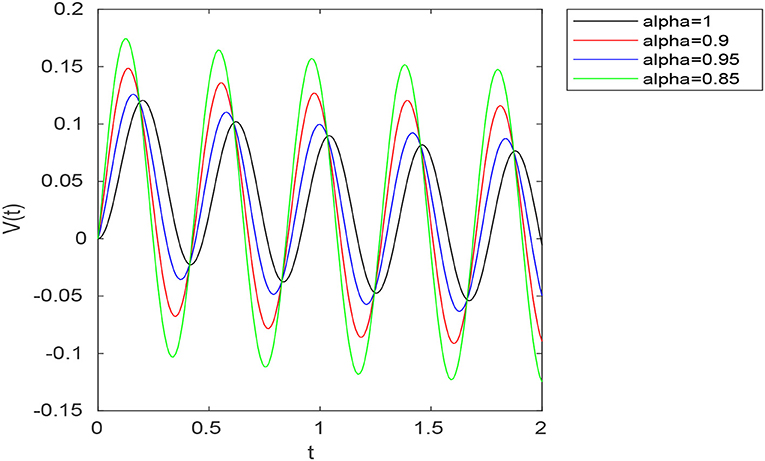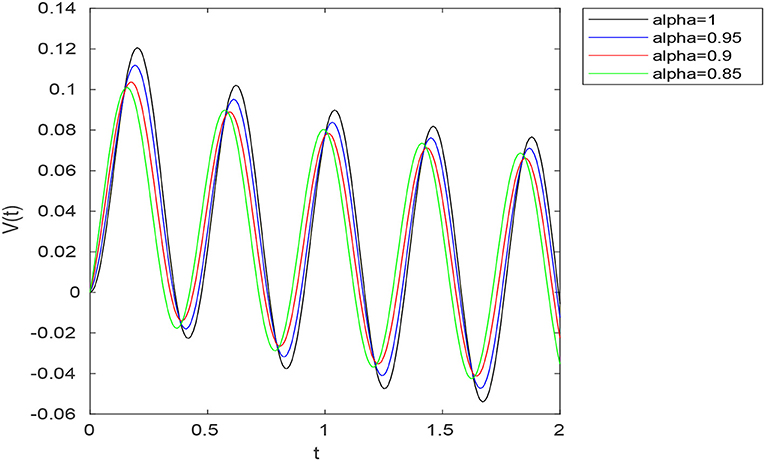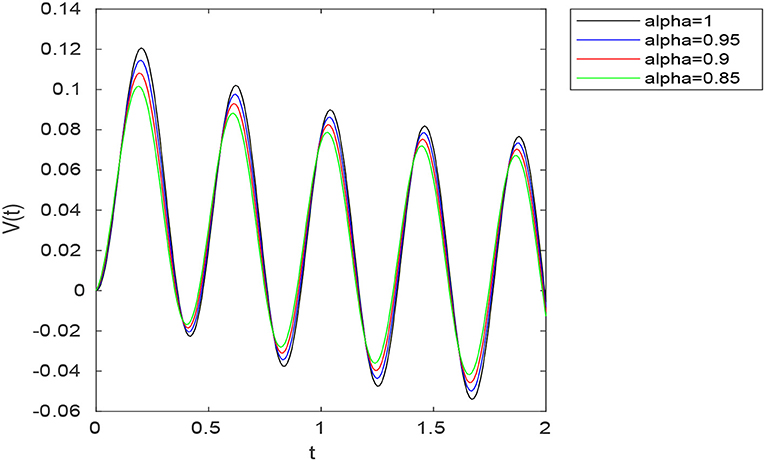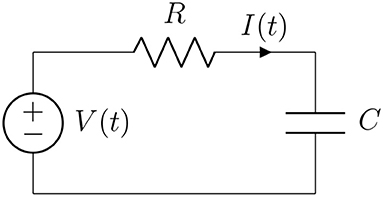Generalization of Caputo-Fabrizio Fractional Derivative and Applications to Electrical Circuits
- 1Department of Mathematics, College of Science, King Saud University, Riyadh, Saudi Arabia
- 2Department of Mathematics, National Institute of Technology, Jamshedpur, India
A new fractional derivative with a non-singular kernel involving exponential and trigonometric functions is proposed in this paper. The suggested fractional operator includes as a special case Caputo-Fabrizio fractional derivative. Theoretical and numerical studies of fractional differential equations involving this new concept are presented. Next, some applications to RC-electrical circuits are provided.
1. Introduction
In the recent decades, the theory of fractional calculus has brought the attention of a great number of researchers in various disciplines. Indeed, it was observed that the use of fractional derivatives is very useful for modeling many problems in engineering sciences (see e.g., [1–10]). Various notions of fractional derivatives exist in the literature. The basic notions are those introduced by Riemann-Liouville and Caputo (see e.g., [11]), which involve the singular kernel , 0 < α < 1. These fractional derivatives play an important role for modeling many phenomena in physics. However, as it was mentioned in Caputo and Fabrizio [12], certain phenomena related to material heterogeneities cannot be well-modeled using Riemann-Liouville or Caputo fractional derivatives. Due to this fact, Caputo and Fabrizio [12] suggested a new fractional derivative involving the non-singular kernel , 0 < α < 1. Later, Caputo-Fabrizio fractional derivative was used by many authors for modeling various problems in engineering sciences (see e.g., [13–24]). Furthermore, other fractional derivatives with non-singular kernels were introduced by some authors (see e.g., [10, 25–29]).
In this paper, a new fractional derivative with a non-singular kernel involving exponential and trigonometric functions is proposed. The introduced fractional derivative includes as a special case Caputo-Fabrizio fractional derivative. Theoretical and numerical investigations of fractional differential equations involving this new fractional operator are presented. Next, some applications to electrical circuits are provided.
In section 2, some preliminaries on harmonic analysis are presented. In section 3, we develop a general theory of fractional calculus using an arbitrary non-singular kernel. In section 4, we introduce a generalized Caputo-Fabrizio fractional derivative and study its properties. Some applications to fractional differential equations are given in section 5. A numerical method based on Picard iterations is presented in section 6 with some numerical examples. In section 7, some applications to RC-electrical circuits are provided.
2. Some Preliminaries on Harmonic Analysis
We recall briefly some results on harmonic analysis that will be used later.
Lemma 2.1. Folland [30]. Let ψ ∈ L1(ℝ) be such that
Consider the sequence of functions {ψε}ε>0 defined by
If μ ∈ L1(ℝ), then
and
where * denotes the convolution product.
Lemma 2.2. Let ψ ∈ L1(0, ∞) be such that
Consider the sequence of functions {ψε}ε>0 defined by
If μ ∈ L1(0, ∞), then the sequence of functions defined by
satisfies the following properties:
and
Proof: For any function f defined almost every where in (0, ∞), let
From (2.1), one has and
Hence, by Lemma 2.1, for all f ∈ L1(ℝ), we have
and
where
In particular, for μ ∈ L1(0, ∞), we have
and
For all t > 0, we have
Hence, using (2.2) and (2.3), one obtains
and
This completes the proof of Lemma 2.2.
□
Definition 2.1. We say that f is of exponential order θ, if for t large enough, one has
where C > 0 and θ are constants.
We denote by the Laplace transform of the function f, i.e.,
Recall that, if f ∈ C[0, ∞) and f is of exponential order θ, then exists for s > θ.
We denote by ℕ the set of positive integers.
Lemma 2.3. Schiff [31]. Let n ∈ ℕ. If f ∈ Cn[0, ∞) and for all i = 0, 1, ⋯ , n − 1, the function f(i) is of exponential order, then
3. Fractional Derivative With an Arbitrary Non-singular Kernel
We consider the set of non-singular kernel functions
Definition 3.1. Given , 0 < α < 1 and f ∈ C1[0, ∞), the fractional derivative of order α of f with respect to the non-singular kernel function k is defined by
Remark 3.1. We can also define for functions f ∈ AC[0, ∞) (f is an absolutely continuous function in [0, ∞)). In this case, f′(t) exists for almost every where t > 0 and f′ ∈ L1(0, ∞).
The following properties hold.
Theorem 3.1. Let and f ∈ C1[0, ∞). Then
(i) For all 0 < α < 1,
(ii) If f′ ∈ L1(0, ∞), one has
and
Proof: (i) Let 0 < α < 1. For 0 < t<T < ∞, one has
where . Passing to the limit as t → 0+ in the above inequality, (i) follows.(ii) Suppose that f′ ∈ L1(0, ∞). For 0 < α < 1, let . One has
where
Hence, using Lemma 2.2, (ii) follows.
□
Definition 3.2. Given , 0 < α < 1, n ∈ ℕ∪{0} and f ∈ Cn + 1[0, ∞), the fractional derivative of order α+n of f with respect to the non-singular kernel k is defined by
Remark 3.2. We can also define for functions f ∈ ACn + 1[0, ∞). In this case, fn + 1(t) exists for almost every where t > 0 and f(n + 1) ∈ L1(0, ∞).
Similarly to the case n = 0, one has
Theorem 3.2. Let , n ∈ ℕ ∪{0} and f ∈ Cn + 1[0, ∞). Then
(i) For all 0 < α < 1,
(ii) If f(n + 1) ∈ L1(0, ∞), then
and
Remark 3.3. From the assertion (ii) of Theorem 3.2, if f(n+1) ∈ L1(0, ∞), one has
Theorem 3.3. Given , 0 < α < 1, n ∈ ℕ ∪{0} and f ∈ Cn + 1[0, ∞) with f(i), i = 0, 1, ⋯ , n, are of exponential order, one has
where
Proof: One has
Using Fubini's theorem, one obtains
Using the change of variable τ = t − σ, it holds
Hence, by (3.2), one deduces that
Next, using Lemma 2.3, we obtain
which yields the desired result.
□
4. A Generalized Caputo-Fabrizio Fractional Derivative
Consider the kernel function
where a > 0 and b ≥ 0 are constants. It can be easily seen that
where is the set of kernel functions defined by (3.1). Hence, using Definition 3.2, we define the fractional derivative with respect to the kernel function ka, b as follows.
Definition 4.1. Given a > 0, b ≥ 0, 0 < α < 1, n ∈ ℕ∪{0} and f ∈ Cn + 1[0, ∞), the fractional derivative of order α+n of f with respect to the kernel function ka, b is defined by
Remark 4.1. Taking a = 1 and b = 0 in the above definition, one obtains
where is the Caputo–Fabrizio fractional derivative operator of order α + n (see [12]).
Remark 4.2. Definition 4.1 can be extended to the case of functions f ∈ Cn + 1[0, T], where 0 < T < ∞.
From (4.1) and Theorem 3.2, one deduces that
Corollary 4.1. Let a > 0, b ≥ 0, n ∈ ℕ∪{0} and f ∈ Cn + 1[0, ∞). Then
(i) For all 0 < α < 1,
(ii) If f(n + 1) ∈ L1(0, ∞), then
and
Let
that is,
Lemma 4.1. Abramowitz and Stegun [32]. Let a > 0, b ≥ 0 and 0 < α < 1. Then
Using Theorem 3.3 and Lemma 4.1, one deduces that
Corollary 4.2. Let a > 0, b ≥ 0, 0 < α < 1, n ∈ ℕ∪{0} and f ∈ Cn + 1[0, ∞) with f(i), i = 0, 1, ⋯ , n, are of exponential order. Then
For n = 0, one obtains
Corollary 4.3. Let a > 0, b ≥ 0, 0 < α < 1 and f ∈ C1[0, ∞) with f is of exponential order. Then
5. Applications to Fractional Differential Equations
Let a > 0, b ≥ 0, 0 < T < ∞ and 0 < α < 1.
Definition 5.1. Let g ∈ C[0, T]. The fractional integral of order α of g is defined by
with .
Given f0 ∈ ℝ and g ∈ C1[0, T] with g(0) = 0, we consider the initial value problem
Theorem 5.1. Problem (5.1) admits a unique solution f ∈ C1[0, T], which is given by
Proof: Let f ∈ C1[0, T] be a solution of (5.1). One has
By Definition 4.1, one has
where
On the other hand,
Integrating the above equality and using that γ(0) = 0, one obtains
Hence by (5.4), one deduces that
Next, using (5.3), one obtains
Integrating the above equality, using that f(0) = f0 and g(0) = 0, it holds
On the other hand, using Fubini's theorem, one gets
It follows from (5.5) and (5.6) that
i.e., f is a solution of (5.2).
Suppose now that f satisfies (5.2). Clearly, one has f ∈ C1[0, T]. Since g(0) = 0, one has f(0) = f0. On the other hand, an elementary calculation shows that for all 0 < t < T. Therefore, f is a solution of (5.2).
□
Consider now the non-linear initial value problem
where the function F:[0, T] × ℝ → ℝ is continuous and satisfies F(0, u0) = 0.
Definition 5.2. We say that u ∈ C[0, T] is a weak solution of (5.7), if u solves the integral equation
i.e.,
for all 0 ≤ t ≤ T.
Remark 5.1. Observe that, if F ∈ C1([0, T] × ℝ), and u ∈ C1[0, T] is a solution of (5.7), then u ∈ C[0, T] is a weak solution of (5.7).
Theorem 5.2. Suppose that
where ℓ > 0 is a constant. If
where and , then (5.7) admits a unique weak solution u* ∈ C[0, T]. Moreover, for any z0 ∈ C[0, T], the Picard sequence {zn} defined by
for all 0 ≤ t ≤ T, converges uniformly to u*.
Proof: Consider the self-mapping H : C[0, T] → C[0, T] defined by
for all 0 ≤ t ≤ T. We endow C[0, T] with the norm
Then (C[0, T], ||·||∞) is a Banach space. For all u, v ∈ C[0, T] and 0 ≤ t ≤ T, using (5.8), one has
which yields
Hence by (5.9), one deduces that H is a contraction. Therefore, the result follows from Banach fixed point theorem.
□
6. Numerical Solution via Picard Iteration
Consider the initial value problem
where 0 < α < 1. For α = 1, (6.1) reduces to
The exact solution of (6.2) is given by
(6.1) is a special case of (5.7) with T = 1, a = b = 1, u0 = −3 and . One can check easily that F satisfies (5.8) with . Moreover, one has
Hence by Theorem 5.2, (6.1) has a unique weak solution u* ∈ C[0, 1]. Consider now the Picard sequence {zn} ⊂ C[0, 1] given by z0(t) = −3 and
for all n = 0, 1, , 2, ⋯ By Theorem 5.2, the sequence {zn} converges uniformly to u*. In Figure 1A, for α = 0.95, we plot u1(t) [the exact solution of (6.2)], z1(t), z3(t), and z10(t). In Figure 1B, for α = 0.7, we plot z1(t), z3(t), and z10(t).
7. Applications to RC Electrical Circuits
In this section, we give some applications to RC electrical circuits using the generalized Caputo-Fabrizio fractional derivative introduced in section 4.
The governing ODE of an RC electrical circuit (see Figure 2) is given by
where V is the voltage, R is the resistance, C is the capacitance and μ(t) is the source of volt. In this part, we consider a fractional version of (7.1) using the generalized Caputo-Fabrizio fractional derivative introduced in section 4. Namely, using the following transformation suggested in [33]:
where σ is a positive parameter having dimensions of seconds, we obtain the fractional differential equation
where
We consider (7.3) with the source term
and the initial condition
In this case, (7.3) reduces to
where and B = −A. Applying the Laplace transform and using Corollary 4.3, one obtains
Using (7.4), it holds
where
By Laplace transform inverse, one gets
Examples. All simulations are obtained using MATLAB 7.5. Consider an RC circuit with R = 10Ω, C = 0.1F, ϕ = 15 and σ = RCα. In this case, we have , A = −α1−α(RC)−α and B = α1−α(RC)−α. Figure 3 shows the voltage V(t) for different values of α in the case (a, b) = (1, 0) (Caputo-Fabrizio case). Figure 4 shows the voltage V(t) for different values of α in the case . Figure 5 shows the voltage V(t) for different values of α in the case (a, b) = (10, 3).

Figure 3. Graph of the voltage in the RC circuit for different values of α with μ(t) = sin(15t) and (a, b) = (1, 0).

Figure 4. Graph of the voltage in the RC circuit for different values of α with μ(t) = sin(15t) and .

Figure 5. Graph of the voltage in the RC circuit for different values of α with μ(t) = sin(15t) and (a, b) = (10, 3).
8. Conclusion
In this contribution, we suggested a fractional derivative involving the kernel function
In the particular case (a, b) = (1, 0), the above function reduces to Caputo-Fabrizio kernel. We studied fractional differential equations via this new concept in both theoretical and numerical aspects. In the theoretical point of view, we investigated the existence and uniqueness of solutions to non-linear fractional boundary value problems involving the new introduced fractional derivative. Namely, using Banach fixed point theorem, the existence and uniqueness of weak solutions to (5.7) was established under certain conditions imposed on the non-linear term F and the parameters a, b and α. In the numerical point of view, a numerical algorithm based on Picard iterations was proposed for solving the considered problem. Numerical experiments were provided using as a model example the fractional boundary value problem (6.1). In Figure 1, we presented the exact solution (u1(t)) for α = 1 and numerical solutions z1(t), z3(t), and z10(t) to (6.1) for α ∈ {0.95, 0.7}. One observes that for n = 10, zn(t) is close enough to u1(t), which confirms the convergence of the proposed algorithm. Finally, as application, we proposed a fractional model of an RC electrical circuit using the new introduced fractional derivative. One can compare the voltage V(t) obtained for different values of α in the Caputo-Fabrizio case (a, b) = (1, 0) (see Figure 3) with that obtained using different values of (a, b) (see Figures 4, 5). Namely, one can show that the voltage V(t) obtained with the use of the generalized fractional Caputo-Fabrizio derivative is more stable with respect to α than that obtained with the use of Caputo-Fabrizio fractional derivative.
Data Availability Statement
All datasets generated for this study are included in the article/supplementary material.
Author Contributions
All authors listed have made a substantial, direct and intellectual contribution to the work, and approved it for publication.
Funding
BS was supported by Researchers Supporting Project RSP-2019/4, King Saud University, Riyadh, Saudi Arabia.
Conflict of Interest
The authors declare that the research was conducted in the absence of any commercial or financial relationships that could be construed as a potential conflict of interest.
References
1. Frunzo L, Garra R, Giusti A, Luongo V. Modeling biological systems with an improved fractional Gompertz law. Commun Nonlinear Sci Num. (2019) 74:260–7. doi: 10.1016/j.cnsns.2019.03.024
2. Gao W, Veeresha P, Prakasha D, Baskonus HM, Yel G. A powerful approach for fractional Drinfeld-Sokolov-Wilson equation with Mittag-Leffler law. Alex Eng J. (2019) 58:1301–11. doi: 10.1016/j.aej.2019.11.002
3. Gao W, Yel G, Baskonus HM, Cattani C. Complex solitons in the conformable (2+1)-dimensional Ablowitz-Kaup-Newell-Segur equation. AIMS Math. (2020) 5:507–21. doi: 10.3934/math.2020034
4. Jleli M, Kirane M, Samet B. A numerical approach based on ln-shifted Legendre polynomials for solving a fractional model of pollution. Math Methods Appl Sci. (2017) 40:7356–67. doi: 10.1002/mma.4534
5. Qin S, Liu F, Turner I, Yang Q, Yu Q. Modelling anomalous diffusion using fractional Bloch-Torrey equations on approximate irregular domains. Comput Math Appl. (2018) 75:7–21. doi: 10.1016/j.camwa.2017.08.032
6. Song F, Yang H. Modeling and analysis of fractional neutral disturbance waves in arterial vessels. Math Model Nat Phenom. (2019) 14:301. doi: 10.1051/mmnp/2018072
7. Srivastava H, Gunerhan H. Analytical and approximate solutions of fractional-order susceptible-infected-recovered epidemic model of childhood disease. Math Methods Appl Sci. (2019) 42:935–41. doi: 10.1002/mma.5396
8. Srivastava H, Saad K. Some new models of the time-fractional gas dynamics equation. Adv Math Model Appl. (2018) 3:5–17.
9. Yang X, Machado J, Baleanu D. Exact traveling-wave solution for local fractional Boussinesq equation in fractal domain. Fractals. (2018) 25:1740006. doi: 10.1142/S0218348X17400060
10. Yang X, Mahmoud A, Cattani C. A new general fractional-order derivative with Rabotnov fractional-exponential kernel applied to model the anomalous heat transfer. Therm Sci. (2019) 23:1677–81. doi: 10.2298/TSCI180825254Y
11. Machado J, Kiryakova V, Mainardi F. Recent history of fractional calculus. Commun Nonlinear Sci Numer Simul. (2011) 16:1140–53. doi: 10.1016/j.cnsns.2010.05.027
12. Caputo M, Fabrizio M. A new definition of fractional derivative without singular kernel. Progr Fract Differ Appl. (2015) 1:1–13. doi: 10.12785/pfda/010201
13. Ali F, Saqib M, Khan I, Sheikh N. Application of Caputo-Fabrizio derivatives to MHD free convection flow of generalized Walters'-B fluid model. Eur Phys J Plus. (2016) 131:377. doi: 10.1140/epjp/i2016-16377-x
14. Atangana A. On the new fractional derivative and application to nonlinear Fisher's reaction-diffusion equation. Appl Math Comput. (2016) 273:948–56. doi: 10.1016/j.amc.2015.10.021
15. Bhatter S, Mathur A, Kumar D, Singh J. A new analysis of fractional Drinfeld–Sokolov–Wilson model with exponential memory. Phys A. (2020) 573:122578. doi: 10.1016/j.physa.2019.122578
16. Caputo M, Fabrizio M. Applications of new time and spatial fractional derivatives with exponential kernels. Progr Fract Differ Appl. (2016) 2:1–11. doi: 10.18576/pfda/020101
17. Gao F, Yang XJ. Fractional Maxwell fluid with fractional derivative without singular kernel. Therm Sci. (2016) 20:871–7. doi: 10.2298/TSCI16S3871G
18. Gómez-Aguilar J, Yépez-Martinez H, Calderón-Ramón C, Cruz-Orduna I, Escobar-Jiménez R, Olivares-Peregrinoictor V. Modeling of a mass-spring-damper system by fractional derivatives with and without a singular kernel. Entropy. (2015) 17:6289–303. doi: 10.3390/e17096289
19. Hristov J. Transient heat diffusion with a non-singular fading memory: from the Cattaneo constitutive equation with Jeffrey's kernel to the Caputo-Fabrizio time-fractional derivative. Therm Sci. (2016) 20:765–70. doi: 10.2298/TSCI160112019H
20. Kumar D, Singh J, Al Qurashi ADB. A new fractional SIRS-SI malaria disease model with application of vaccines, antimalarial drugs, and spraying. Adv Differ Equat. (2019) 2019:278. doi: 10.1186/s13662-019-2199-9
21. Kumar D, Singh J, Baleanu D, Sushila D. Analysis of regularized long-wave equation associated with a new fractional operator with Mittag-Leffler type kernel. Phys A. (2018) 492:155–67. doi: 10.1016/j.physa.2017.10.002
22. Kumar D, Singh J, Tanwar K, Baleanu D. A new fractional exothermic reactions model having constant heat source in porous media with power, exponential and Mittag-Leffler laws. Int J Heat Mass Transf. (2019) 138:1222–7. doi: 10.1016/j.ijheatmasstransfer.2019.04.094
23. Losada J, Nieto J. Properties of a new fractional derivative without singular kernel. Progr Fract Differ Appl. (2015) 1:87–92. doi: 10.12785/pfda/010202
24. Singh J, Kumar D, Baleanu D. New aspects of fractional Biswas-Milovic model with Mittag-Leffler law. Math Model Nat Phenom. (2019) 14:303. doi: 10.1051/mmnp/2018068
25. Atangana A, Baleanu D. New fractional derivative with non-local and non-singular kernel. Therm Sci. (2016) 20:757–63. doi: 10.2298/TSCI160111018A
26. Gao W, Ghanbari B, Baskonus HM. New numerical simulations for some real world problems with Atangana-Baleanu fractional derivative. Chaos Solit Fract. (2019) 128:34–43. doi: 10.1016/j.chaos.2019.07.037
27. Jarad F, Abdeljawad T, Hammouch Z. On a class of ordinary differential equations in the frame of Atangana-Baleanu fractional derivative. Chaos Solit Fract. (2019) 117:16–20. doi: 10.1016/j.chaos.2018.10.006
28. Kumar D, Singh J, Baleanu D. On the analysis of vibration equation involving a fractional derivative with Mittag-Leffler law. Math Methods Appl Sci. (2019) 43:443–57. doi: 10.1002/mma.5903
29. Singh J, Kumar D, Hammouch Z, Atangana A. A fractional epidemiological model for computer viruses pertaining to a new fractional derivative. Appl Math Comput. (2018) 316:504–15. doi: 10.1016/j.amc.2017.08.048
30. Folland GB. Fourier Analysis and Its Applications. Providence, RI: American Mathematical Society (1992).
32. Abramowitz M, Stegun I. Handbook of Mathematical Functions With Formulas, Graphs, and Mathematical Tables. New York, NY: Dover (1972).
Keywords: fractional derivative, non-singular kernel, Picard iteration, RC-electrical circuit, convergence
Citation: Alshabanat A, Jleli M, Kumar S and Samet B (2020) Generalization of Caputo-Fabrizio Fractional Derivative and Applications to Electrical Circuits. Front. Phys. 8:64. doi: 10.3389/fphy.2020.00064
Received: 25 December 2019; Accepted: 28 February 2020;
Published: 20 March 2020.
Edited by:
Jagdev Singh, JECRC University, IndiaReviewed by:
Haci Mehmet Baskonus, Harran University, TurkeyDevendra Kumar, University of Rajasthan, India
Copyright © 2020 Alshabanat, Jleli, Kumar and Samet. This is an open-access article distributed under the terms of the Creative Commons Attribution License (CC BY). The use, distribution or reproduction in other forums is permitted, provided the original author(s) and the copyright owner(s) are credited and that the original publication in this journal is cited, in accordance with accepted academic practice. No use, distribution or reproduction is permitted which does not comply with these terms.
*Correspondence: Sunil Kumar, skumar.math@nitjsr.ac.in
 Amal Alshabanat
Amal Alshabanat Mohamed Jleli
Mohamed Jleli Sunil Kumar
Sunil Kumar Bessem Samet
Bessem Samet
